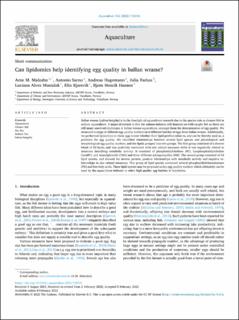| dc.contributor.author | Malzahn, Arne | |
| dc.contributor.author | Sarno, Antonio | |
| dc.contributor.author | Hagemann, Andreas | |
| dc.contributor.author | Farkas, Julia | |
| dc.contributor.author | Musialak, Luciana Alves | |
| dc.contributor.author | Kjørsvik, Elin | |
| dc.contributor.author | Hansen, Bjørn Henrik | |
| dc.date.accessioned | 2023-02-03T09:59:55Z | |
| dc.date.available | 2023-02-03T09:59:55Z | |
| dc.date.created | 2022-02-14T11:05:20Z | |
| dc.date.issued | 2022 | |
| dc.identifier.citation | Aquaculture. 2022, 552 1-6. | en_US |
| dc.identifier.issn | 0044-8486 | |
| dc.identifier.uri | https://hdl.handle.net/11250/3048216 | |
| dc.description.abstract | Ballan wrasse (Labrus bergylta) is in the limelight of aquaculture research due to the species role as cleaner fish in salmon aquaculture. A major drawback is that the salmon industry still depends on wild caught fish as there are still many unsolved challenges in ballan wrasse aquaculture, amongst them the determination of egg quality. We measured a range of different egg quality markers on 6 different batches of eggs from ballan wrasse. Additionally, we performed lipidomics on these eggs to test whether their lipid profiles relate to, and can be thereby used as, a predictor for egg quality. We identified relationships between several lipid species and physiological and morphological egg quality markers, and the lipids grouped into two groups. The first group consisted of a diverse blend of 32 lipids, and was positively correlated with size related measures while it was negatively related to measures describing metabolic activity. It consisted of phosphatidylcholines (PC), lysophosphatidylcholine (lysoPC), and triacylglicerids (TAG) and three different sphingomyelins (SM). The second group consisted of 24 lipid species, and showed the inverse pattern, positive relationships with metabolic activity and negative relationships to size related measures. This group of lipid species contained several phosphatidylethanolamines (PE) and free fatty acids. These lipid species may be proposed as key egg quality markers which ultimately can be used by the aquaculture industry to select high quality egg batches in hatcheries. | en_US |
| dc.language.iso | eng | en_US |
| dc.publisher | Elsevier | en_US |
| dc.rights | Navngivelse 4.0 Internasjonal | * |
| dc.rights.uri | http://creativecommons.org/licenses/by/4.0/deed.no | * |
| dc.subject | licelabrus bergylta | en_US |
| dc.subject | Salmon | en_US |
| dc.subject | Sea lice | en_US |
| dc.subject | Cleaner fish | en_US |
| dc.subject | Aquaculture | en_US |
| dc.title | Can lipidomics help identifying egg quality in ballan wrasse? | en_US |
| dc.title.alternative | Can lipidomics help identifying egg quality in ballan wrasse? | en_US |
| dc.type | Peer reviewed | en_US |
| dc.type | Journal article | en_US |
| dc.description.version | publishedVersion | en_US |
| dc.rights.holder | © 2022 The Authors. Published by Elsevier B.V | en_US |
| dc.source.pagenumber | 1-6 | en_US |
| dc.source.volume | 552 | en_US |
| dc.source.journal | Aquaculture | en_US |
| dc.identifier.doi | 10.1016/j.aquaculture.2022.738018 | |
| dc.identifier.cristin | 2001222 | |
| dc.relation.project | Fiskeri- og havbruksnæringens forskningsfinansiering: 901561 | en_US |
| dc.source.articlenumber | 738018 | en_US |
| cristin.ispublished | true | |
| cristin.fulltext | original | |
| cristin.qualitycode | 2 | |

